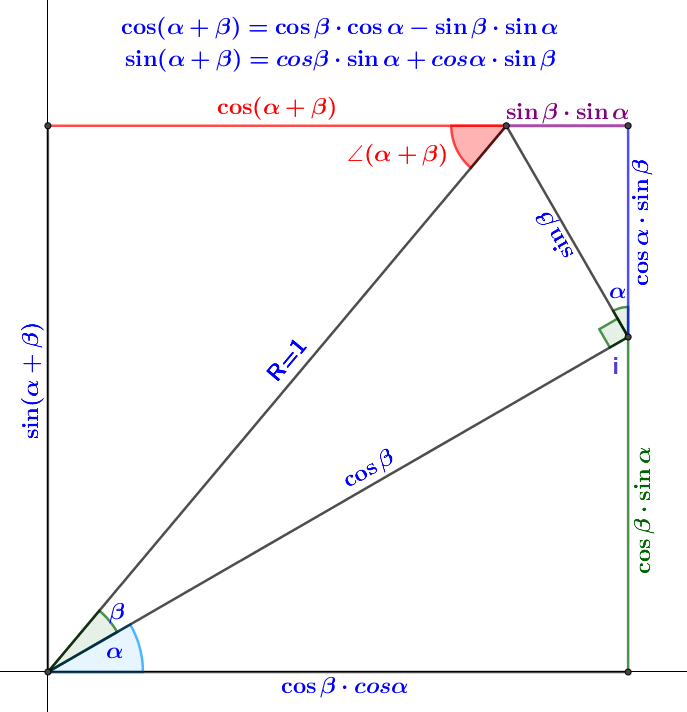Trig Identities
Most people, including many scientists, get through their whole career without ever finding a need for trig identities. For example, I have a reasonably good scientific calculator and while it has sin, arcsine, cos, arccos, tan, arctan, it doesn't have any of the reciprocal trig functions. There is no cosecant (csc), secant (sec), or cotangent (cot), and they haven't been missed. If these were to occur, they are nothing more than definitions of the Pythagorean triangle side ratios. A primary use for these reciprocal trig functions is for calculus integration, where they aid in simplifying the integrals. $$\begin{array}{c} \sin(\theta)=1/\csc(\theta)\\ \cos(\theta)=1/\sec(\theta)\\ \tan(\theta)=1/\cot(\theta) \end{array} \tag{1} \label{1}$$

From the labels on a unit circle $$\tan(\theta)=\sin(\theta)/\cos(\theta). \tag{2} \label{2}$$ The tangent identity $\eqref{2}$, follows directly from the definition of tangent as $opposite/adjacent$. If we use the Pythagorean formula on the sides of the triangle in that same unit circle, we get $$1=\sin^{2}(\theta)+\cos^{2}(\theta) \tag{3} \label{3}$$ Now I get into what I would call less common identities and I will start with the sum formula. $$\sin(\phi+\theta)=\sin(\phi)\cos(\theta)+\sin(\theta)\cos(\phi) \tag{4} \label{4}$$ equation $\eqref{4}$ is not obvious but, along with its rearrangements it can be useful. The similar identities are $$sin(\phi-\theta)=\sin(\phi)\cos(\theta)-\sin(\theta)\cos(\phi) \tag{5} \label{5}$$ $$\cos(\phi+\theta)=\cos(\phi)\cos(\theta)-\sin(\phi)\sin(\theta) \tag{6} \label{6}$$ $$\cos(\phi-\theta)=\cos(\phi)\cos(\theta)+\sin(\phi)\sin(\theta) \tag{7} \label{7}$$ $$\sin(2\theta)=2\sin(\theta)\cos(\theta) \tag{8} \label{8}$$ $$\cos(2\theta)=\cos^{2}(\theta)-\sin^{2}(\theta) \tag{9} \label{9}$$ $$\cos(\theta)=1-2\sin^{2}(\theta/2) \tag{10} \label{10}$$ $$\cos(2\theta)=1-2\sin^{2}(\theta) \tag{11} \label{11}$$ $$\cos(\theta)=2\cos^{2}(\frac{\theta}{2})-1 \tag{12} \label{12}$$ $$\sin^{2}(\theta)=\frac{1}{2}-\frac{1}{2}\cos(2\theta) \tag{13} \label{13}$$ Let's use these identities to expand $\sin(3\phi)$ into something more simple. In this context, it is always more simple to not have a multiplier in front of the angle. $$\begin{align*} \sin(3\phi) & =\\ = & \sin(2\phi+\phi)\qquad\text{obviously}\\ = & \sin(2\phi)\cos(\phi)+\cos(2\phi)\sin(\phi)\qquad\text{sum identity Ref: $\eqref{4}$ }\\ = & 2\sin(\phi)\cos(\phi)\cos(\phi)+(1-2\sin^{2}\phi)\sin(\phi)\qquad\text{$\eqref{8}$ and $\eqref{9}$ combined with $\eqref{3}$.}\\ = & 2\sin(\phi)\cos^{2}(\phi)+\sin(\phi)-2\sin^{3}(\phi)\qquad\text{algebra }\\ = & 2\sin(\phi)(1-\sin^{2}(\phi))+\sin(\phi)-2\sin^{3}(\phi)\qquad \eqref{3}\\ = & 2\sin(\phi)-2\sin^{3}(\phi)+\sin(\phi)-2\sin^{3}(\phi)\qquad\text{algebra }\\ = & 3\sin(\phi)-4\sin^{3}(\phi)\qquad\text{algebra} \end{align*}$$ As we can see, using the sum identity or the half angle identities, many trig functions can be expanded into forms that only contain $\sin(\theta)$ and $\cos(\theta)$.
Using Trig Identities
A standard trig problem is $$\quad a\cdot\cos(x)+b\cdot \sin(x)=c. \tag{14} \label{14}$$ Find $x$.
The problem only has a solution if $|c|\le\sqrt{a^{2}+b^{2}}$. The solution involves some not obvious steps as well as the trig identity $$\cos(\phi-\theta)=\cos(\phi)\cos(\theta)+\sin(\phi)\sin(\theta).$$ Here is how to solve it. Although this solution may arrive at a formula, we can't just remember all formulas and it is better to learn the steps of the solution.
Step 1: Let $a=R\cos\alpha$ and $b=R\sin\alpha$. We could immediately substitute these into $\eqref{14}$ but that isn't useful, so be patient.
Step 2: Using the substitutions of step 1, we are going to add $a^2+b^2$ and solve for $R$. $$a^{2}+b^{2}=R^{2}\cos^{2}\alpha+R^{2}\sin^{2}\alpha$$ Rearrange and use $1=sin^{2}(\theta)+cos^{2}(\theta)$ to simplify. $$a^{2}+b^{2}=R^{2}\left[\cos^{2}\alpha+\sin^{2}\alpha\right]=R^{2}$$ $$R=\sqrt{a^{2}+b^{2}} \tag{15} \label{15}$$
Step 3: Here we will use the substitution definitions in step 1 to solve for $\alpha$. Thus far, we continue to ignore the original problem. We note the definition for tangent of $\alpha$ and extend it so that we get a ratio with $a$ and $b$. $$\tan\alpha=\frac{\sin\alpha}{\cos\alpha}=\frac{R\sin\alpha}{R\cos\alpha}=\frac{b}{a}$$ $$\alpha=\tan^{-1}\left(\frac{b}{a}\right) \tag{16} \label{16}$$ So far, in the three steps we have made a substitution for constants $a$ and $b$ in terms of $R$ and $\alpha$ and we have redefined $R$ and $\alpha$ in terms of $a$ and $b$.
Step 4: Now we will introduce our substitution into the original problem and factor out $R$. $$R\,\cos\alpha\cos\,x+R\,\sin\alpha\sin\,x=c$$ $$R\left[\cos\alpha\cos\,x+\sin\alpha\sin\,x\right]=c \tag{17} \label{17}$$
Step 5: Inside the brackets of $\eqref{17}$ we can match a trig identity: $\cos(\phi-\theta)=\cos(\phi)\cos(\theta)+\sin(\phi)\sin(\theta)$. Making the substitutions, we can write $$R\left[\cos\left(x-\alpha\right)\right]=c.$$ Note that we have yet to involve variable $c$ and that everything thus far could have been done to change $a\,\cos\,x+b\,\sin\,x$. Continuing with the substitutions for $R$ and $\alpha$. $$\sqrt{a^{2}+b^{2}}\,\cos\left(x-\tan^{-1}\left(\frac{b}{a}\right)\right)=c \tag{18} \label{18}$$
From here, we can just solve the equation for $x$, $$x-\tan^{-1}\left(\frac{b}{a}\right)=\cos^{-1}\left(\frac{c}{\sqrt{a^{2}+b^{2}}}\right)$$ and $$x=\cos^{-1}\left(\frac{c}{\sqrt{a^{2}+b^{2}}}\right)+\tan^{-1}\left(\frac{b}{a}\right). \tag{20} \label{20}$$
Angle Sum Identity Proof

The proof of the two angle sum identities derive from figure 2. This proof is valid for acute angles. Extending it to greater angles is a little more work.
- Begin with two angles, $\alpha$ and $\beta$ coming from the origin. Label the upper line that delimits these angles with $R=1$ to mean that it has length $1$.
- Construct a perpendicular line from the end of line $R=1$ down to the ray between angles $\alpha$ and $\beta$. From the standard trig functions, we can label the adjacent side $\cos\beta$ and the opposite side $\sin\beta$.
- From the triangle constructed by steps 1 and 2, construct a rectangle around the triangle, as seen in figure 2.
- The angle labeled $\angle(\alpha+\beta)$ is a parallel line transversal. Its opposite side is $\sin(\alpha+\beta)$ and its adjacent side is $\cos(\alpha+\beta)$.
- Looking at the lower triangle with angle $\alpha$, its adjacent side is $\text{hyp}\cdot\cos\alpha$ which is $\cos\beta\cdot\cos\alpha$. Similarly, its opposite side is $\cos\beta\cdot\sin\alpha$.
- In the upper right triangle, we have identified the angle $\alpha$. We know it is $\alpha$ because the lower triangle has three angles, $90^{\circ},\alpha,$ and $i$. Those add to $180^{\circ.}$ The right side is a $180^{\circ}$ straight line that includes angle $i$ and a $90^{\circ}$ and a third angle. Therefore, the third angle must be $\alpha$.
- The upper right triangle has an adjacent side, $\sin\beta\cdot\cos\alpha$ and an opposite side, $\sin\beta\cdot\sin\alpha$.
- From the top and bottom side lengths, we get $\cos(\alpha+\beta)=\cos\beta\cdot\cos\alpha-\sin\beta\cdot\sin\alpha$. From the left and right side lengths, we get $\sin(\alpha+\beta)=\cos\beta\cdot\sin\alpha+\cos\alpha\cdot\sin\beta$.